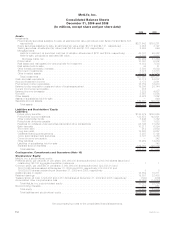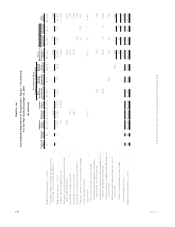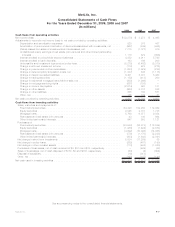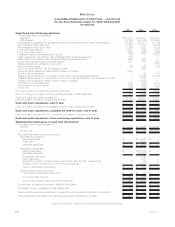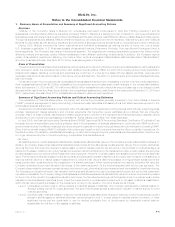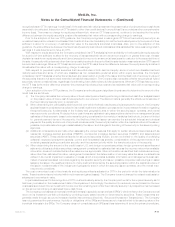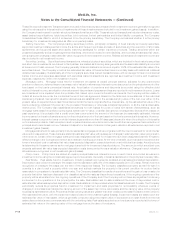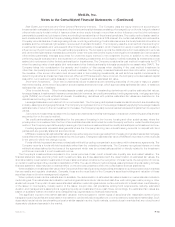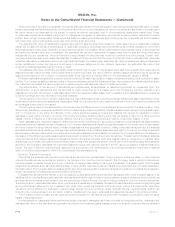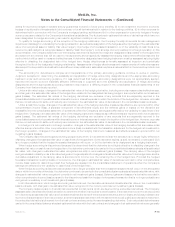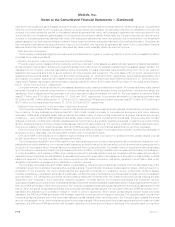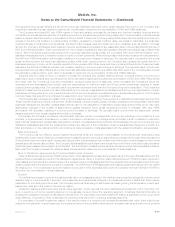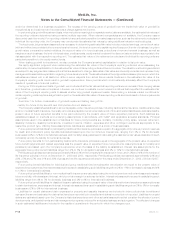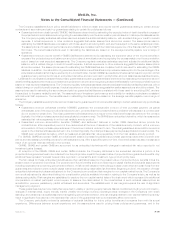MetLife 2009 Annual Report Download - page 96
Download and view the complete annual report
Please find page 96 of the 2009 MetLife annual report below. You can navigate through the pages in the report by either clicking on the pages listed below, or by using the keyword search tool below to find specific information within the annual report.These Structured Investment Transactions are included in fixed maturity securities and their investment income is generally recognized
using the retrospective interest method. Impairments of these investments are included in net investment gains (losses). In addition,
the Company has invested in certain structured transactions that are VIEs. These structured transactions include reinsurance trusts,
asset-backed securitizations, hybrid securities, joint ventures, limited partnerships and limited liability companies. The Company
consolidates those VIEs for which it is deemed to be the primary beneficiary. The Company reconsiders whether it is the primary
beneficiary for investments designated as VIEs on a quarterly basis.
Trading Securities. The Company’s trading securities portfolio, principally consisting of fixed maturity and equity securities,
supports investment strategies that involve the active and frequent purchase and sale of securities and the execution of short sale
agreements, and supports asset and liability matching strategies for certain insurance products. Trading securities which are
presented separately and short sale agreement liabilities, which are included in other liabilities, are recorded at estimated fair value,
with subsequent changes in estimated fair value recognized in net investment income. Related dividends and investment income are
also included in net investment income.
Securities Lending. Securities loaned transactions, whereby blocks of securities, which are included in fixed maturity securities
and short-term investments, are loaned to third parties, are treated as financing arrangements and the associated liability is recorded
at the amount of cash received. The Company generally obtains collateral in an amount equal to 102% of the estimated fair value of the
securities loaned. The Company monitors the estimated fair value of the securities loaned on a daily basis with additional collateral
obtained as necessary. Substantially all of the Company’s securities loaned transactions are with brokerage firms and commercial
banks. Income and expenses associated with securities loaned transactions are reported as investment income and investment
expense, respectively, within net investment income.
Mortgage Loans. Mortgage loans held-for-investment are stated at unpaid principal balance, adjusted for any unamortized
premium or discount, deferred fees or expenses, net of valuation allowances. Interest income is accrued on the principal amount of the
loan based on the loan’s contractual interest rate. Amortization of premiums and discounts is recorded using the effective yield
method. Interest income, amortization of premiums and discounts and prepayment fees are reported in net investment income. Loans
are considered to be impaired when it is probable that, based upon current information and events, the Company will be unable to
collect all amounts due under the contractual terms of the loan agreement. Based on the facts and circumstances of the individual
loans being impaired, loan specific valuation allowances are established for the excess carrying value of the loan over either: (i) the
present value of expected future cash flows discounted at the loan’s original effective interest rate, (ii) the estimated fair value of the
loan’s underlying collateral if the loan is in the process of foreclosure or otherwise collateral dependent, or (iii) the loan’s observable
market price. The Company also establishes allowances for loan losses for pools of loans with similar characteristics, such as
mortgage loans based on similar property types, similar loan-to-value, or similar debt service coverage ratio factors when, based on
past experience, it is probable that a credit event has occurred and the amount of the loss can be reasonably estimated. Interest
income earned on impaired loans is accrued on the principal amount of the loan based on the loan’s contractual interest rate. However,
interest ceases to accrue for loans on which interest is generally more than 60 days past due and/or when the collection of interest is
not considered probable. Cash receipts on such impaired loans are recorded in accordance with the loan agreement as a reduction of
principal and/or as interest income. Gains and losses from the sale of loans and changes in valuation allowances are reported in net
investment gains (losses).
Mortgage loans held-for-sale primarily include residential mortgages which are originated with the intent to sell and for which the fair
value option was elected. These loans are stated at estimated fair value with subsequent changes in estimated fair value recognized in
other revenue. Certain other mortgage loans previously designated as held-for-investment have been designated as held-for-sale to
reflect a change in the Company’s intention as it relates to holding such loans. At the time of transfer, such loans are recorded at the
lower of amortized cost or estimated fair value less expected disposition costs determined on an individual loan basis. Amortized cost
is determined in the same manner as for mortgage loans held-for-investment described above. The amount by which amortized cost
exceeds estimated fair value less expected disposition costs is accounted for as a valuation allowance. Changes in such valuation
allowance are recognized in net investment gains (losses).
Policy Loans. Policy loans are stated at unpaid principal balances. Interest income on such loans is recorded as earned in
investment income using the contractually agreed upon interest rate. Generally, interest is capitalized on the policy’s anniversary date.
Real Estate. Real estate held-for-investment, including related improvements, is stated at cost less accumulated depreciation.
Depreciation is provided on a straight-line basis over the estimated useful life of the asset (typically 20 to 55 years). Rental income is
recognized on a straight-line basis over the term of the respective leases. The Company classifies a property as held-for-sale if it
commits to a plan to sell a property within one year and actively markets the property in its current condition for a price that is
reasonable in comparison to its estimated fair value. The Company classifies the results of operations and the gain or loss on sale of a
property that either has been disposed of or classified as held-for-sale as discontinued operations, if the ongoing operations of the
property will be eliminated from the ongoing operations of the Company and if the Company will not have any significant continuing
involvement in the operations of the property after the sale. Real estate held-for-sale is stated at the lower of depreciated cost or
estimated fair value less expected disposition costs. Real estate is not depreciated while it is classified as held-for-sale. The Company
periodically reviews its properties held-for-investment for impairment and tests properties for recoverability whenever events or
changes in circumstances indicate the carrying amount of the asset may not be recoverable and the carrying value of the property
exceeds its estimated fair value. Properties whose carrying values are greater than their undiscounted cash flows are written down to
their estimated fair value, with the impairment loss included in net investment gains (losses). Impairment losses are based upon the
estimated fair value of real estate, which is generally computed using the present value of expected future cash flows from the real
estate discounted at a rate commensurate with the underlying risks. Real estate acquired upon foreclosure is recorded at the lower of
estimated fair value or the carrying value of the mortgage loan at the date of foreclosure.
F-12 MetLife, Inc.
MetLife, Inc.
Notes to the Consolidated Financial Statements — (Continued)


